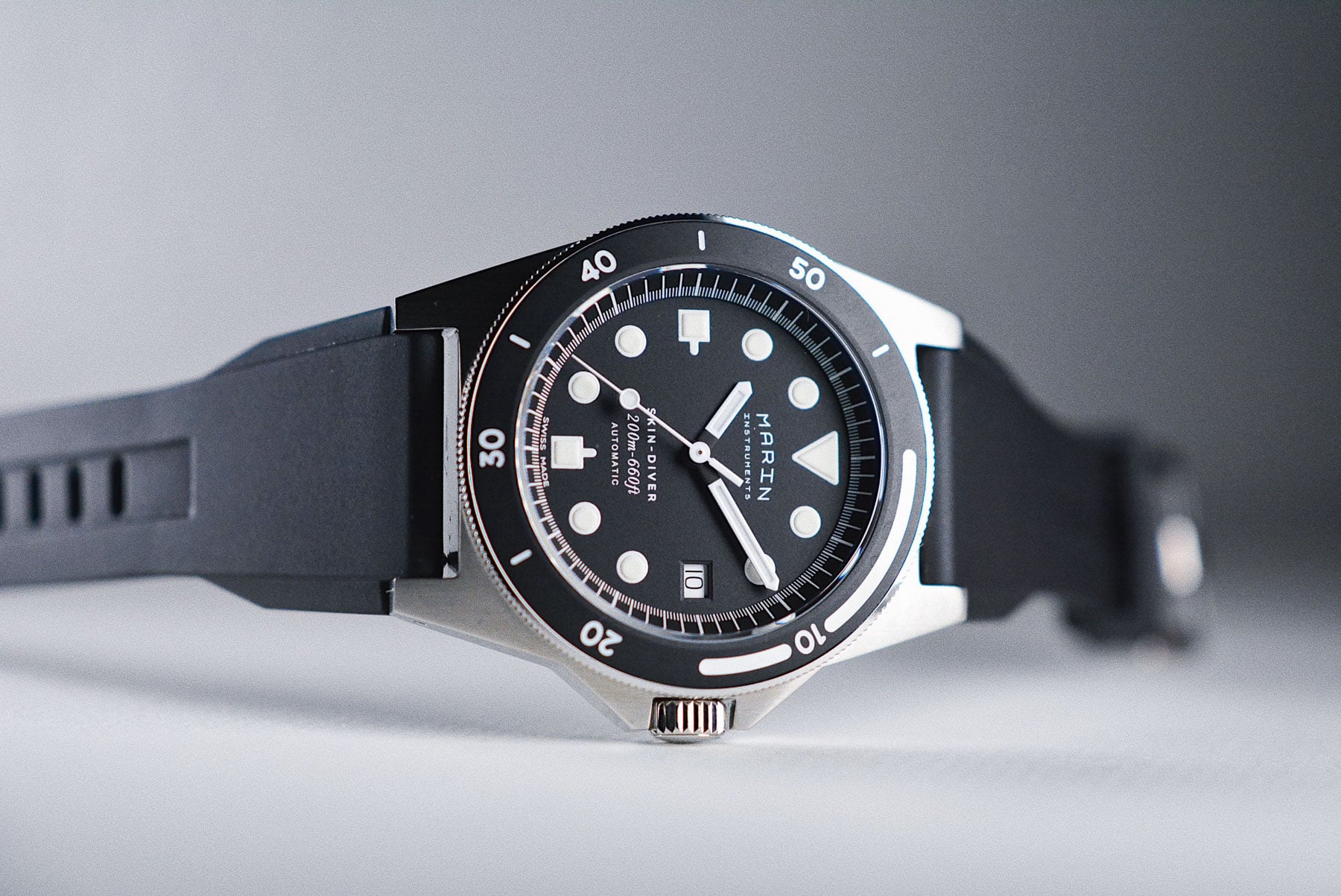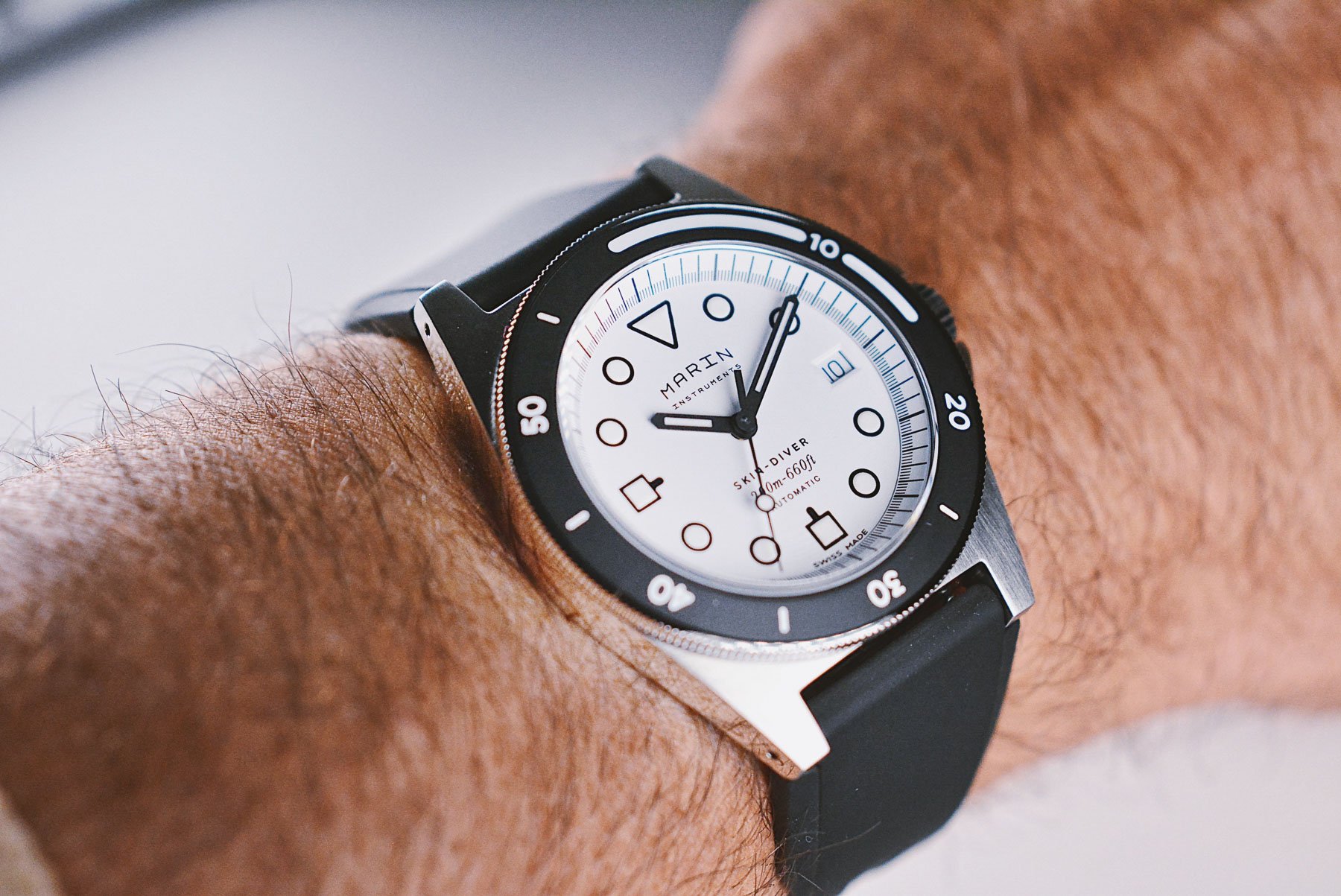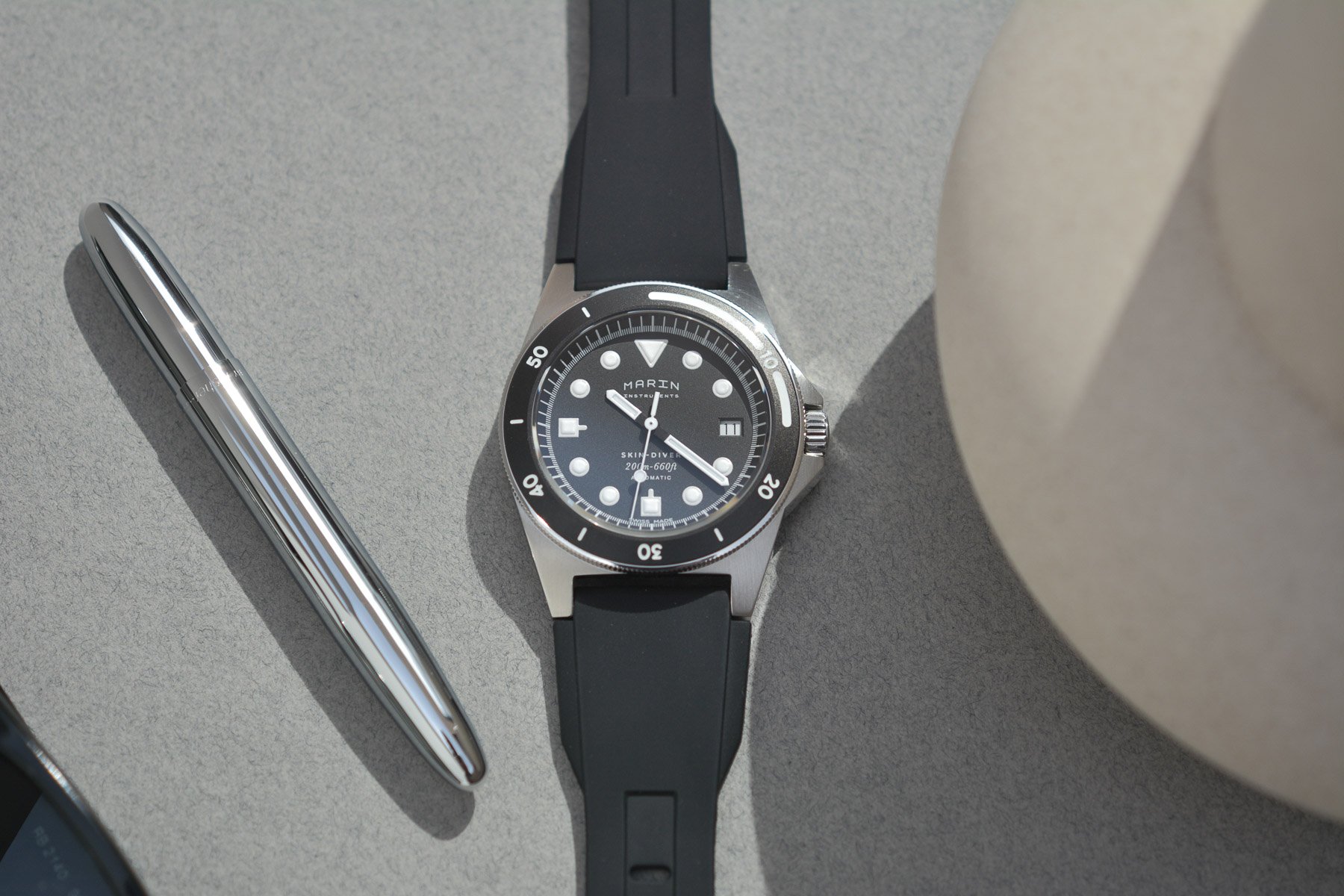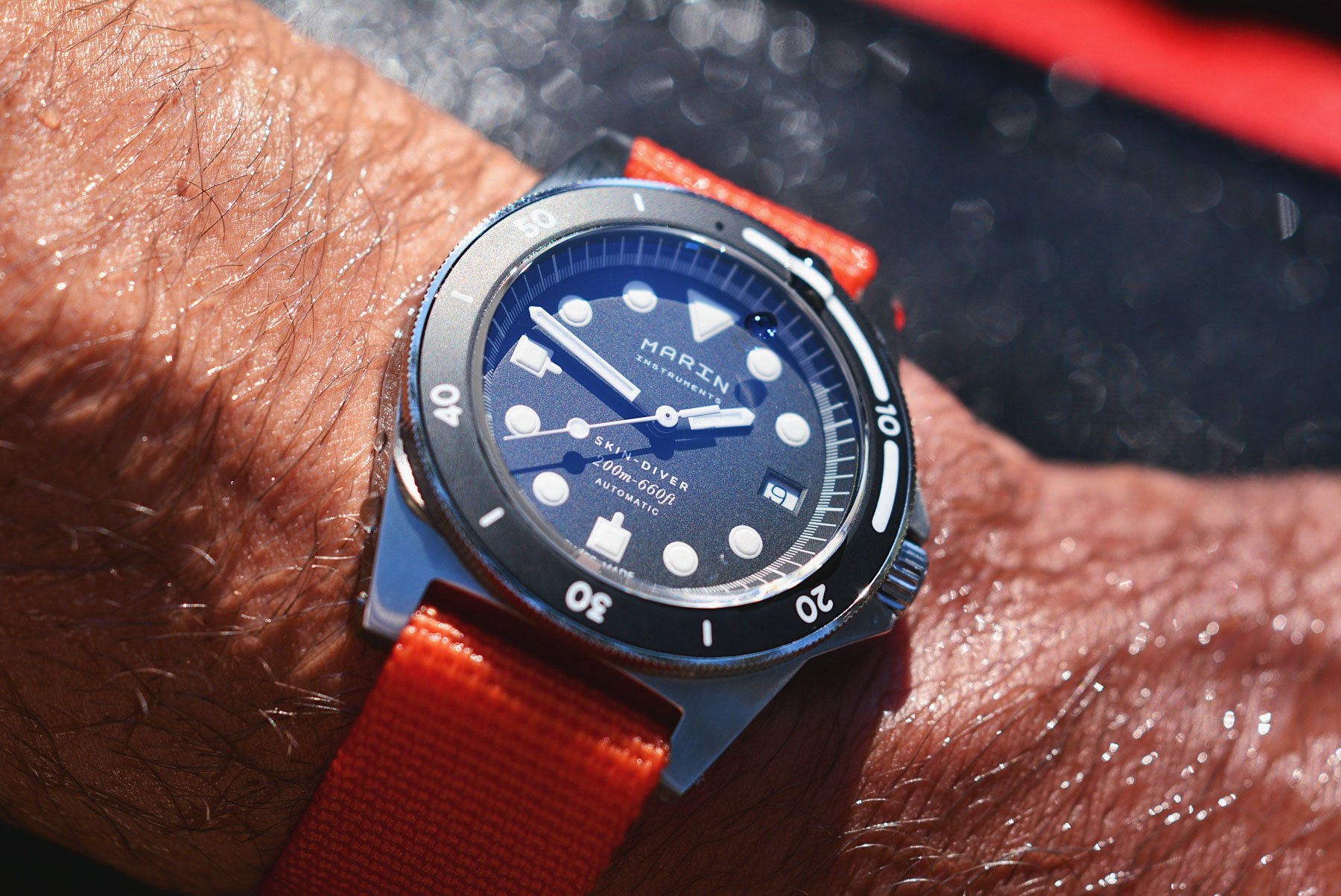Hands-On: The Marin Instruments Skin-Diver
A long time ago, my watch journey began with dive watches. I was lucky to grow feet in the water, and I loved everything related to the sea. Plus, I’ve always been obsessed with watches, so the decision to buy divers was a no-brainer. Many of my watch friends own dive watches. Three Fratello writers’ GADA watches are divers. And much of the outstanding watch photography that populates Instagram is of dive watches. Moreover, we adore vintage and neo-vintage examples and, more specifically, skin divers. Though there’s a lot to love there, I find that the Marin Instruments Skin-Diver offers something a little different. It is a skin diver that doesn’t look like a vintage one. In other words, it’s a modern skin diver. Easy, right?
So let’s talk about it. For great reads on divers that do something others can’t, I recommend a few articles. The first is Nacho’s tale of his GADA Seamaster. After reading that, check out Thomas’s excellent hands-on with the Tudor Black Bay 54 and Brandon’s article on his GADA Submariner ref. 114060. These will hopefully give context to this hands-on review of the Marin Instruments Skin-Diver. Looking at its specs, this watch could be categorized as a “professional” diver. From a visual standpoint, however, it borrows some key elements from vintage skin divers without leaning too much into the past. To get a key piece of information out of the way, the Skin-Diver retails for US$1,150.
What is a skin diver, and what could a modern one look like?
Skin divers became popular in the early 1960s as alternatives to the professional dive watches released in the 1950s. Professional divers were deemed too chunky and over-engineered for regular folks, so brands started making smaller dive watches that all looked more or less the same with flat cases, straight-cut lugs, no polishing, and smaller dimensions. They were meant to be worn on the skin for snorkeling instead of a wetsuit for diving. Generally speaking, they had 100m depth ratings, automatic movements, and legible dials. I’ve handled a few vintage skin divers, and I just can’t get enough of this type of watch. The smaller cases work best for my skinny wrist. They also looked cool, which explains why many brands have recreated and paid homage to them. But as far as I know, few brands today make original dive watches that they market as skin divers.
Once you read the specs of the Marin Instruments, you might not feel it’s an actual skin diver. That brings me to my next point: it’s a modern skin diver that borrows the case design from the old ones. It is long and flat with right angles, massive lugs shaped like Batman’s shadow, a mostly brushed finish, and a flat bezel. The case of the Skin-Diver means business. It’s to be worn anywhere but in a conference room, but it looks best by the sea or on a beach, paired with a NATO or single-pass strap. It looks odd on metal bracelets, and I’ve tried a few. It is, therefore, a watch meant for the outdoors and adventures. Whenever I think of 1960s skin divers, I picture a couple shore diving in the Bahamas. That’s the type of environment a modern skin diver like this one excels in.
A skin diver with professional DNA
I’m going to proceed with caution here as I’m not entirely sure what a “professional dive watch” is in 2023. People throw the word “professional” around a lot, and it has lost its meaning. People who dive professionally (i.e. commercial divers) don’t use Rolex or Omega watches. Instead, they use dive computers or Citizens and G-Shocks. That said, the Marin Instruments Skin-Diver has key specs that could make anyone comfortable taking it deep diving. First, it has a 200m water resistance rating thanks to a screw-down crown and case back. That’s way better water resistance than I need daily. The Skin-Diver also has a flat sapphire crystal and a 60-click unidirectional bezel. The watch is shipped with a custom-made Marin rubber strap (more on that later) and a Maratac Zulu single-pass. Both options are comfortable to wear and look great.
The bezel, which I mentioned above, has a silky-smooth and precise action that’s akin to a $3,000 Seiko dive watch. The insert is sandblasted and fully lumed. Marin Instruments came up with its own twist for the design of the count-up scale. The first 15 minutes are indicated by a straight line, with the five-minute increments thereafter alternating between Arabic numerals and hash marks. It’s extremely legible and easy to use. The rubber strap, also mentioned above, was made specifically for the brand. It flares out at the lugs and tapers down dramatically towards the buckle. Not only does it look unique, but it also makes the watch sit comfortably on the wrist. The hardware used is top-notch, and everything functions as it should.
Now would be a good time to mention the movement within. It’s a Sellita SW200-1 caliber that beats at 28,800vph and has a 38-hour power reserve. The SW200-1 is far from a novelty, but it is a solid, reliable choice here.
How the Marin Instruments Skin-Diver fits
Being modern, the Marin Instruments Skin-Diver does not have the smaller dimensions of its 1960s counterparts. The case measures 39mm in diameter, 48mm long, 11.5mm thick, and 20mm between the drilled lugs. It’s not a large piece by any measure, but it doesn’t feel “skinny.” Being long and wide, the lugs make the watch look larger than its dimensions might suggest. However, it wears just right on my 16cm (6.25”) wrist and looks best on the rubber strap or a thin NATO. Thicker straps tend to make the Skin Diver bulky and heavy. Offsetting the case’s physical dimensions and appearance is a monochromatic dial that is heavenly legible (a plus in my book). What also makes this watch wear well is the reasonable 11.5mm thickness despite its 200m depth rating
Lastly, let’s talk about the dial and what I consider to be a very legible element of the design. The painted hour markers are tall because they consist of many layers of BGW9 Super-LumiNova. The inverted triangle at 12 contrasts nicely with the rectangular markers at 6 and 9 o’clock and the circular ones everywhere else. These hour markers are certainly large in comparison to the thin pencil-style hour and minute hands, but the latter are not so small that they are hard to see in low-light conditions. Thankfully, the lume is really good. A fully graduated minute track graces the sloped rehaut for precise time reading. Finally, an unframed date window sits at 6 o’clock with numerals painted in black against a white disc. In this case, not color-matching the date wheel to the dial works like a charm.
Final thoughts
The skin-diver-like element of the Marin Instruments Skin-Diver is its case shape. You’ve probably seen it on many vintage divers from the 1960s and ’70s and countless homages. That said, the brand created something rather unique here by marrying this case with this particular dial layout. The black dial is legible and discreet, giving the Skin Diver the air of a proper tool watch. Marin Instruments also makes a Polar version with a white dial, black surrounds on the hour markers, and black hands. More recently, the brand also announced a black-dial version with a stainless steel insert. All of them have good looks (at least to me) and great specifications, making the Skin-Diver suitable for any type of wet or dry adventure. It’s also available for a somewhat reasonable price of US$1,150.
What are your thoughts on the Marin Instrument Skin-Diver? Please leave your comments below.













